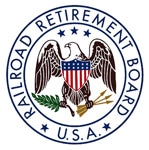
Tier I and Medicare Tax –The railroad retirement Tier I payroll tax rate on covered rail employers and employees for the year 2015 remains at 7.65 percent. The railroad retirement Tier I tax rate is the same as the social security tax, and for withholding and reporting purposes is divided into 6.20 percent for retirement and 1.45 percent for Medicare hospital insurance. The maximum amount of an employee’s earnings subject to the 6.20 percent rate increases from $117,000 to $118,500 in 2015, but there is no maximum on earnings subject to the 1.45 percent Medicare rate.
An additional Medicare payroll tax of 0.9 percent applies to an individual’s income exceeding $200,000 or $250,000 for a married couple filing a joint tax return. While employers will begin withholding the additional Medicare tax as soon as an individual’s wages exceed the $200,000 threshold, the final amount owed or refunded will be calculated as part of the individual’s Federal income tax return.
Tier II Tax – The railroad retirement Tier II tax rate on employees will be 4.9 percent in 2015, and the employers’ rate will be 13.1 percent. The rates in 2014 for employees and employers were 4.4 percent and 12.6 percent, respectively. The maximum amount of earnings subject to railroad retirement Tier II taxes will increase from $87,000 to $88,200 in 2015. Since 2004, Tier II tax rates are based on an average account benefits ratio reflecting railroad retirement fund levels. Depending on this ratio, the Tier II tax rate for employees can be between 0 percent and 4.9 percent, while the Tier II rate for employers can range between 8.2 percent and 22.1 percent.
Unemployment Insurance Contributions – Employers, but not employees, pay railroad unemployment insurance contributions, which are experience-rated by employer. The Railroad Unemployment Insurance Act also provides for a surcharge in the event the Railroad Unemployment Insurance Account balance falls below an indexed threshold amount. The accrual balance of the Railroad Unemployment Insurance Account was $140.8 million on June 30, 2014. Since the balance is less than the indexed threshold of $141.2 million, a 1.5 percent surcharge will be added to the basic contribution rates for 2015, but will not increase the maximum 12 percent rate. There was no surcharge in 2014 or 2013, although a surcharge of 1.5 percent applied in 2012.
As a result, the unemployment insurance contribution rates (including the 1.5 percent surcharge) on railroad employers in 2015 will range from the minimum rate of 2.15 percent to the maximum of 12 percent on monthly compensation up to $1,455, an increase from $1,440 in 2014.
In 2015, the minimum rate of 2.15 percent will apply to 77 percent of covered employers, with 8 percent paying the maximum rate of 12 percent.
During the year, new employers will pay an unemployment insurance contribution rate of 4.09 percent, which represents the average rate paid by all employers in the period 2011-2013.
Related News
- Chairman Pauli Announces Retirement, SMART-TD celebrates his career
- New Mexico Local 1687 sets new precedent with Red Apple Transit
- Tentative Agreement Reached With TransitAmerica Services (TASI)
- New CSX conductor improvises to save a life
- SMART News: Protecting Railroad Retirees’ Future
- More Than a Story: SMART-TD’s Women’s History Month Highlights Legacies in the Making
- Tentative Agreement Reached in Boston
- Assembly, No. 1672
- Historic short-line agreement proves workers are stronger with SMART-TD at their side
- SMART-TD’s Public Comment Opposing CSX’s “Zero-to-Zero” Push